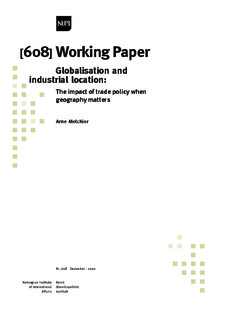| dc.contributor.author | Melchior, Arne | |
| dc.date.accessioned | 2016-06-22T14:16:45Z | |
| dc.date.accessioned | 2016-06-24T13:02:43Z | |
| dc.date.available | 2016-06-22T14:16:45Z | |
| dc.date.available | 2016-06-24T13:02:43Z | |
| dc.date.issued | 2000 | |
| dc.identifier.citation | Working Paper, NUPI nr. 608. NUPI, 2000 | nb_NO |
| dc.identifier.issn | 0800 - 0018 | |
| dc.identifier.uri | http://hdl.handle.net/11250/2394119 | |
| dc.description | - | nb_NO |
| dc.description.abstract | The paper shows how industrial location and welfare
depends on “most-favoured nation” (MFN) versus distance-related trade barriers, using a monopolistic competition model with regions located along a “Hotelling” line or on a square plain. Manufacturing production will cluster close to the periphery if transport costs are relatively high, but in central areas if MFN barriers are relatively high. The peripheries will be at a disadvantage, which increases when trade barriers are reduced. When countries or trading blocs are formed, a core-periphery pattern emerges within each of
them. While lower transport costs create more centralisation within countries, lower MFN barriers between countries have the opposite effect. | nb_NO |
| dc.description.sponsorship | The Norwegian Research Council | nb_NO |
| dc.language.iso | eng | nb_NO |
| dc.publisher | NUPI | nb_NO |
| dc.relation.ispartofseries | NUPI Working Paper;608 | |
| dc.rights | Navngivelse-Ikkekommersiell-DelPåSammeVilkår 3.0 Norge | * |
| dc.rights.uri | http://creativecommons.org/licenses/by-nc-sa/3.0/no/ | * |
| dc.title | Globalisation and industrial location: The impact of trade policy when geography matters | nb_NO |
| dc.type | Working paper | nb_NO |
| dc.date.updated | 2016-06-22T14:16:45Z | |
| dc.source.pagenumber | 25 p. | nb_NO |
| dc.identifier.cristin | 1363408 | |
| dc.subject.keyword | Handel / Trade | |

